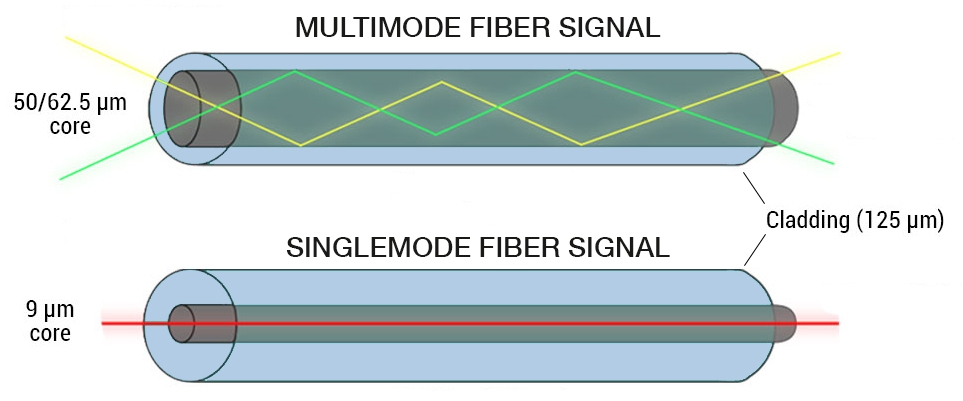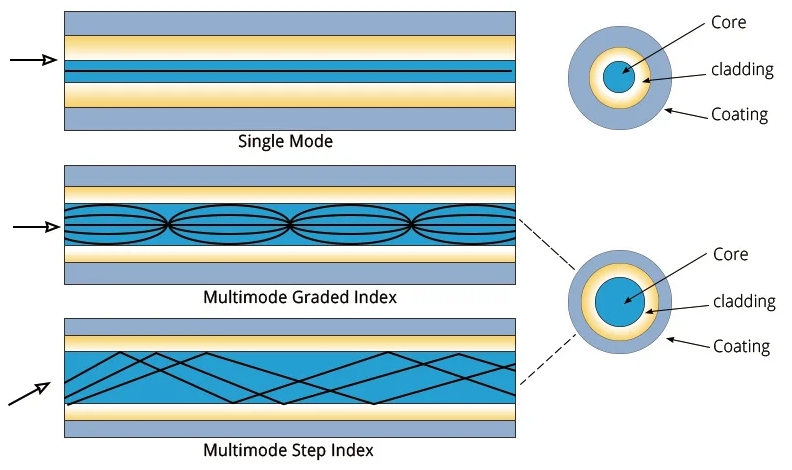Single mode and multimode fiber are two types of optical fiber used in telecommunications and data networking to transmit information over long distances. They differ primarily in the way they propagate light and the distances over which they can effectively transmit data.
Difference Between Single Mode and Multimode Fiber:

Propagation of Light:
Single Mode Fiber: In single mode fiber, the core diameter is very small, typically around 9 micrometers. This small core allows only a single mode of light to propagate through the fiber. Light travels straight down the center of the core without bouncing off the walls, leading to minimal dispersion and attenuation. This makes single mode fiber suitable for long-distance transmission with high bandwidth capabilities.
Multimode Fiber: Multimode fiber has a larger core diameter, typically around 50 or 62.5 micrometers. This larger core allows multiple modes of light to propagate through the fiber. Light reflects off the core walls, resulting in dispersion and modal noise. Multimode fiber is generally used for shorter distances and lower bandwidth applications compared to single mode fiber.
Single Mode Distance VS Multimode Fiber Distance:
Single Mode Fiber Distance: Due to its design with minimal dispersion, single mode fiber can transmit signals over long distances without significant loss of signal quality. It is commonly used in long-haul telecommunications networks and for connections between buildings in a campus or metropolitan area network.
Multimode Fiber Distance: Multimode fiber is suitable for shorter distances, typically up to a few kilometers. Beyond certain distances, modal dispersion becomes a significant issue, limiting the achievable data rates and overall performance.
Single Mode Bandwidth VS Multimode Fiber Bandwidth:
Single Mode Fiber Bandwidth: Single mode fiber offers higher bandwidth compared to multimode fiber. It can support higher data rates over longer distances, making it ideal for high-speed, long-distance applications such as telecommunications backbone networks and high-speed internet connections.
Multimode Fiber Bandwidth: While multimode fiber has lower bandwidth compared to single mode fiber, it is still capable of supporting moderate data rates suitable for local area networks (LANs), data centers, and shorter-distance applications.

Single Mode Cost VS Multimode Fiber Cost:
Single Mode Fiber Cost: Single mode fiber tends to be more expensive than multimode fiber, both in terms of the fiber itself and the associated components such as transceivers. However, its higher performance and longer reach justify the investment in many long-distance applications.
Multimode Fiber Cost: Multimode fiber is generally more cost-effective than single mode fiber, making it a popular choice for shorter-distance connections where high bandwidth is not critical.
In summary, the choice between single mode and multimode fiber depends on factors such as distance requirements, bandwidth needs, and budget constraints. Single mode fiber is favored for long-distance, high-bandwidth applications, while multimode fiber is suitable for shorter distances and lower bandwidth requirements.
04-24
202404-23
202404-23
202404-08
202404-07
202403-26
202403-26
202403-18
202403-18
202403-13
2024
